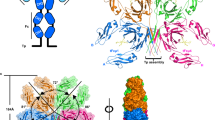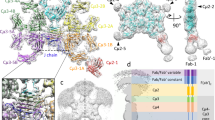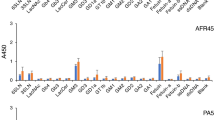Abstract
THE immunoglobulins G1 represent the major component of human immunoglobulins, with a basic four chain structure consisting of two heavy and two light chains joined by disulphide bridges1. (The nomenclature used is based on that recommended by the World Health Organization (1966).) The light chains are made up of two sections—an invariable C-terminal section characteristic of each type, and a variable N-terminal section specific to each clone2–4. Peptide maps of Fd fragments5,6 suggest that a similar situation holds in heavy chains. In light chains the two sections are folded, each by a single disulphide bridge, to give two loops of almost equal size—the invariable C-terminal loop and the variable N-terminal loop7. The Fc region of human G immunoglobulins includes two intrachain disulphide bridges which impose on it a ring structure, again made up of an N-terminal and a C-terminal loop, resembling the ring structure of light chains8. In this communication, we present evidence which suggests further similarities between disulphide bridges of light and heavy chains. We also present results concerning a peptide containing both the heavy-light and heavy-heavy interchain disulphide bridges.
This is a preview of subscription content, access via your institution
Access options
Subscribe to this journal
Receive 51 print issues and online access
$199.00 per year
only $3.90 per issue
Buy this article
- Purchase on Springer Link
- Instant access to full article PDF
Prices may be subject to local taxes which are calculated during checkout
Similar content being viewed by others
References
Cohen, S., and Porter, R. R., Adv. Immunol., 4, 287 (1964).
Hilschmann, N., and Craig, L. C., Proc. US Nat. Acad. Sci., 53, 1403 (1965).
Titani, K., Whitley, E., Avogardo, L., and Putnam, F. W., Science, 149, 1090 (1965).
Milstein, C., Biochem. J., 101, 338 (1966).
Frangione, B., and Franklin, F. C., J. Exp. Med., 122, 1 (1965).
Frangione, B., Prelli, F., and Franklin, E. C., Immunochemistry, 4, 95 (1967).
Milstein, C., Biochem. J., 101, 352 (1966).
Frangione, B., Milstein, C., and Franklin, E. C., Biochem. J. (in the press).
Pink, J. R. L., and Milstein, C., Nature, 214, 92 (1967).
Bull. Wld. Hlth. Org., 30, 447 (1964).
Press, E. M., Biochem. J., 104, 30C (1967).
Steiner, L. A., and Porter, R. R., Biochemistry (in the press).
Singer, S. J., and Doolittle, R. F., Science, 153, 13 (1966).
Hill, R. L., Delaney, R., Fellows, R. E., and Levovitz, H. E., Proc. US Nat. Acad. Sci., 56, 1762 (1966).
Pink, J. R. L., and Milstein, C., Nature, 216, 941 (1967).
Author information
Authors and Affiliations
Rights and permissions
About this article
Cite this article
FRANGIONE, B., MILSTEIN, C. Disulphide Bridges of Immunoglobin G1 Heavy Chains. Nature 216, 939–941 (1967). https://doi.org/10.1038/216939b0
Received:
Issue Date:
DOI: https://doi.org/10.1038/216939b0
This article is cited by
-
Localization of the binding site for the human high-affinity Fc receptor on IgG
Nature (1988)
-
Comparative Study of Two Immunoglobulin G Fd-Fragments
Nature (1969)
-
Immunoglobulins: Structural Studies of Immunoglobulin G
Nature (1969)
-
Immunoglobulins: Chemical Typing of Immunoglobulins
Nature (1969)
-
Partial Deletion in the Heavy Chain Disease Protein ZUC
Nature (1969)
Comments
By submitting a comment you agree to abide by our Terms and Community Guidelines. If you find something abusive or that does not comply with our terms or guidelines please flag it as inappropriate.



